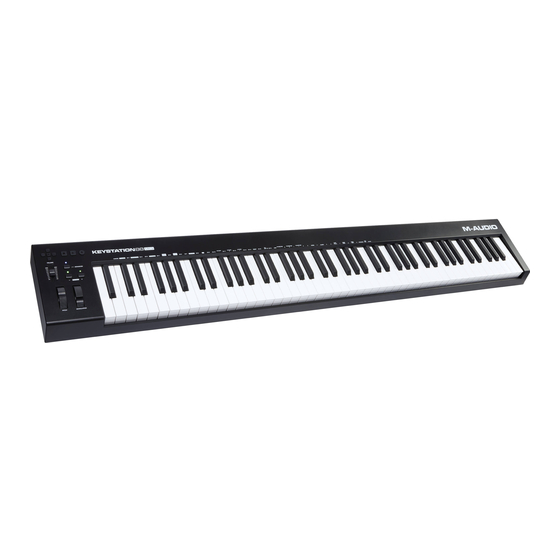
Inhaltszusammenfassung für M-Audio Keystation 88 MK3
-
Seite 2: Inhaltsverzeichnis
® User Guide English ( 3 – 15 ) Guía del usuario Español ( 16 – 28 ) Guide d’utilisation Français ( 29 – 42 ) Guida per l’uso Italiano ( 43 – 56 ) Benutzerhandbuch Deutsch ( 57 – 69 ) Appendix English ( 70 –... -
Seite 58: Deutsch
Benutzerhandbuch (Deutsch) Einführung Vielen Dank für den Kauf des Keystation 88 MK3. Wir von M-Audio wissen, wie wichtig Ihnen die Musik ist. Darum entwerfen wir unsere Geräte stets nur mit einem einzigen Ziel vor Augen: Ihre Performance so gut wie möglich zu unterstützen. -
Seite 59: Empfohlene Installation
Empfohlene Installation Software: Wir liefern Keystation 88 MK3 mit Pro Tools | First M-Audio Edition, MPC Beats, und Ableton Live Lite aus, damit Sie Ihre Musikproduktion gleich mit professioneller Software starten können. Registrieren Sie Ihren Keystation 88 MK3 zuerst auf m-audio.com... - Seite 60 Wählen Sie oben im Fenster unter Bedienoberfläche aus der Dropdownliste in Reihe 1 die Option MackieControl aus. Wählen Sie in der Spalte Eingang in Reihe 1 Keystation 88 MK3 (Port 2) aus. Stellen Sie sicher, dass im dritten Dropdownmenü in Reihe 1 unter Ausgang Kein eingestellt ist. Die Transportsteuerung (Wiedergabe, Stopp und Aufnahme) auf dem Keystation 88 MK3-Controller übernimmt nun die Steuerung entsprechend der Transportfunktionen in Ableton Live Lite.
-
Seite 61: Erste Schritte
Abschnitt geben wir Ihnen ausführliche Hinweise zu den Konfigurationsoptionen, die Sie in Ihrer Audiosoftware vornehmen müssen. Im Abschnitt “MIDI-Geräte” Ihrer Audioanwendung sollte Keystation unter der Bezeichnung “USB Audio Device” (Windows 8) bzw. unter der Bezeichnung “Keystation 88 MK3” (sonstige Betriebssysteme) ausgewiesen sein. Genauere Hinweise Konfiguration... - Seite 62 Lautstärke-Slider: Über den Lautstärke-Slider werden normalerweise MIDI-Befehle zur Regelung der Tonlautstärke gesendet. Sie können dem Slider allerdings auch für andere Kontrollfunktionen wie Pan (Balance), Attack, Reverb, Chorus, uvm. programmieren. Weitere Informationen hierzu entnehmen Sie bitte dem Abschnitt Erweiterte Funktionen. Funktionstaste: Über die Funktionstaste erhalten Sie Zugriff auf die erweiterten Funktionen Ihres Keystation-Keyboards.
- Seite 63 Sie die Tasten gedrückt halten müssen. Hinweis: Für realistische Pedalbetätigung bietet sich das SP-2 an. Das SP-2 ist das umschaltbare Sustain-Pedal von M-Audio, das an den Sustain-Pedal-Eingang von Keystation 88 MK3 angeschlossen werden kann. Hinweis: Die Polarität des Sustain-Pedals wird automatisch ermittelt, sobald Keystation eingeschaltet wird.
-
Seite 64: Erweiterte Funktionen
Erweiterte Funktionen Die beiden Up & Down-Tasten für die Veränderung der Oktavlage (siehe Abschnitt “Oktavtasten”) können zusätzlich für die Steuerung der MIDI-Funktionen genutzt werden. Über Die ersten 7 schwarzen Tasten können sie die gewünschte Spezialfunktion für die Octave Up & Down-Tasten auswählen. -
Seite 65: Control Change
Control Change Folgen Sie zur Zuweisung der Oktave/Daten-Tasten zum Senden von Control Change-Nachrichten, die ein- und ausgeschaltet werden können, diesen Schritten: 1. Drücken Sie die Taste Advanced, um in den Bearbeitungsmodus zu wechseln. 2. Drücken Sie die schwarze Taste mit der Aufschrift „CC‟ (Eb2). 3. -
Seite 66: Program Change
Kanal Mit Keystation verfügen Sie über 16 MIDI-Kanäle für das Senden von MIDI-Daten. Bitte beachten Sie jedoch, dass einige MIDI-Geräte und MIDI-Anwendungen die MIDI-Daten des Keyboards nur über einen bestimmten Kanal empfangen können. In diesem Fall können Sie den Sendekanal wie folgt einstellen: 1. -
Seite 67: Bank Lsb Und Bank Msb
Bank LSB und Bank MSB Program Change ist der am häufigsten verwendete Befehl zur Auswahl von Instrumenten und Stimmen. Allerdings ist die Anzahl der mittels Program Change auszuwählenden Instrumente auf 128 beschränkt. Wenn Sie Geräte mit mehr als 128 Stimmen anzapfen wollen, müssen Sie mit Bank LSB und Bank MSB-Meldungen arbeiten. -
Seite 68: Modulationsrad
Modulationsrad Sie können dem Modulationsrad verschiedene CC- und MIDI-Nachrichten zuweisen. Zu den nützlichen Nachrichten zählen: MIDI CC 01 (Modulation), MIDI CC 07 (Lautstärke), MIDI CC 10 (Pan) und MIDI CC 05 (Portamento). Es gibt insgesamt 132 Nachrichten. Damit diese Nachrichten Auswirkungen auf den Sound haben, muss das empfangende MIDI-Gerät jedoch in der Lage sein, diese MIDI-Nachrichten zu lessen und darauf zu reagieren. - Seite 69 Hier finden Sie Antworten auf häufig gestellte Fragen zur Fehlerbehebung bei den Keyboards der Keystation-Serie. Problem 1: Mein M-Audio-Gerät funktioniert plötzlich nicht mehr, obwohl es seit der Installation problemlos in Betrieb war. Lösung 1: Schalten Sie das Gerät für 10 Sekunden aus. Starten Sie Ihren Computer neu. Sollte das Problem weiter bestehen, müssen Sie eventuell die Gerätetreiber neu installieren.
- Seite 70 MIDI-Funktionen Die Keystation-Keyboards wurden so konstruiert, dass die MIDI-Verarbeitung mit ihrem Computer so einfach wie möglich wird. Nichtsdestotrotz können unter Umständen Schwierigkeiten mit den MIDI-Funktionen auftreten. Oft liegt der Fehler in diesen Fällen nicht am Keyboard, sondern am Empfängergerät. Um dem entgegenzuwirken, gibt es eine nützliche MIDI-Funktion : Reset All Controllers.
- Seite 73 Manual Version 1.2...
